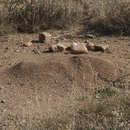en
names in breadcrumbs


The species in this genus are seed-harvesting ants, whose nest mounds are often conspicuously decorated with pebbles. The workers are diurnal and have a potent sting.
Several of the taxa belong to difficult complexes, and species boundaries remain unclear. In neighboring Arizona a series of stabilized hybrid lineages has been documented in the P. barbatus-complex (Helms Cahan et al. 2002).
Species identification: keys in Cole (1966), Wheeler and Wheeler (1986g) and Mackay and Mackay (2002). Additional references: Davidson (1977a), De Vita (1979), Gordon (1999), Groark (2001), Helms Cahan et al. (2002), Hölldobler (1976a, 1976c), Johnson (2000a, 2001), Knudtson (1978), Kusnezov (1951e), Lei (2000), MacKay (1980, 1981, 1982), MacKay and MacKay (1989), O’Dowd and Hay (1980), Olsen (1934), Parker and Rissing (2002), Ryti and Case (1988), Schmidt (1998), Shattuck (1987), Snelling(1982a), Taber (1990, 1998), Taber et al. (1987, 1988), Wheeler (1902a, 1914e).
Pogonomyrmex is a genus of harvester ants, occurring primarily in the deserts of North, Central, and South America, with a single endemic species from Haiti.[2]
The genus name originated from the Greek language and refers to a beard-like structure, the psammophore, below the head (Greek πώγων/pōgōn, "beard" + μύρμηξ/murmēx, "ant"), which can be found in most species of the subgenus sensu stricto. The psammophore is used for gathering small seeds, helping to increase the efficiency of transportation of fine sand and pebbles during nest construction, or to carry eggs. However, this structure is missing in species of the subgenus Ephebomyrmex (Greek ἔφηβος/ephēbos, "beardless lad"), and these species generally have smaller individuals and colonies.
Pogonomyrmex (sensu stricto) workers have the most toxic venom documented in any insects, with Pogonomyrmex maricopa being the most toxic tested thus far.[3] It has an LD50 of only 0.12 mg/kg, compared to western honey bee venom, at 2.8 mg/kg, and comparable to cobra venom. The venom is presumed to be an antivertebrate defense, specifically against predators that have evolved to selectively feed on them such as horned lizards. Very few insects have had the toxicity of their venoms formally tested, and other insects likely have more potent venoms.
These ants dig very deep nests with many underground chambers in which they keep seeds, from which they derive food for their larvae. The areas around most Pogonomyrmex (sensu stricto) nests tend to be utterly devoid of vegetation, and are easily seen from a distance.
In addition to horned lizards, predatory wasps in the genus Clypeadon feed only on Pogonomyrmex workers, paralyzing them with their venom, and carrying them back to a burrow where they will serve as food for the wasp's larva.[2]
As of 2014, there are 69 extant and 1 fossil species in the genus.[1]
Pogonomyrmex is a genus of harvester ants, occurring primarily in the deserts of North, Central, and South America, with a single endemic species from Haiti.